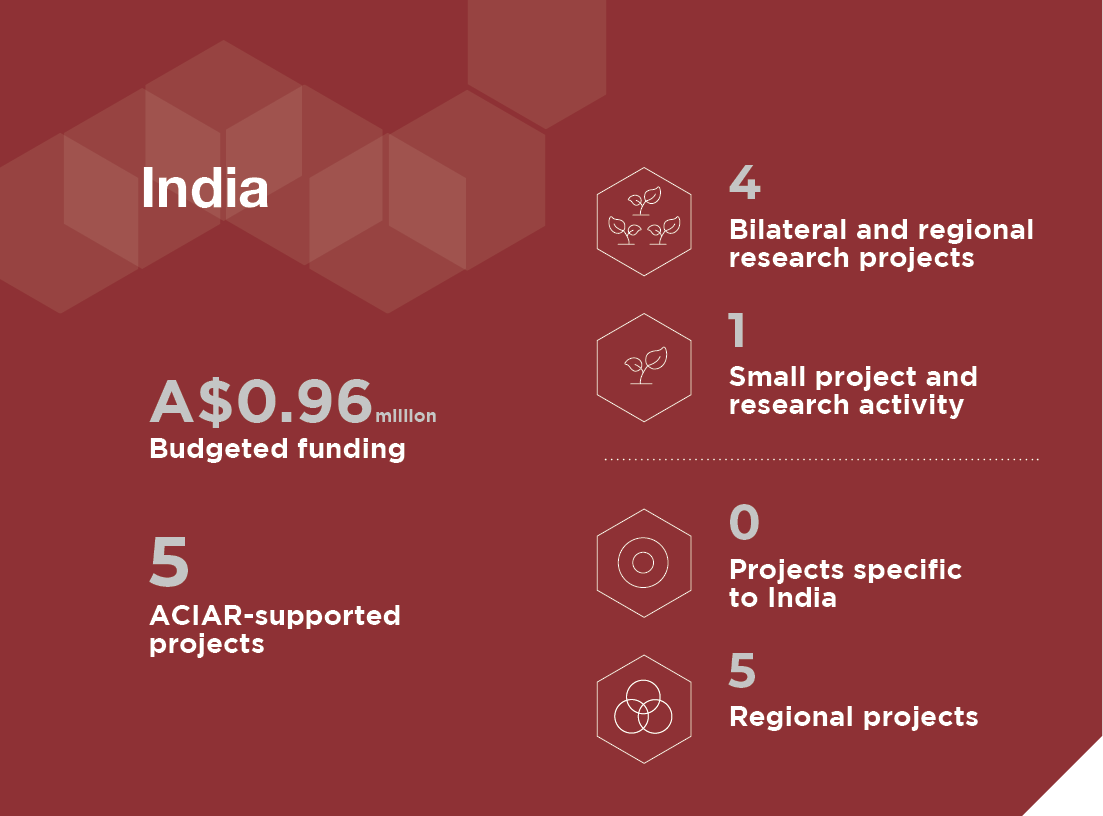India accounts for 18% of the world’s population and is the world’s fifth-largest economy.
India is emerging as a major agricultural exporter of several key commodities and globally is often the largest exporter of rice and the second-largest exporter of cotton. While the contribution of the agriculture sector to GDP is declining, agriculture remains a major source of employment and accounts for 44% of the total national workforce. Agriculture also accounts for nearly 50% of the geographical area of India, and approximately half of the agricultural area is irrigated.
Two-thirds of India’s population lives in rural areas, with landholdings averaging 1.1 hectares. The rural population is highly vulnerable to the impacts of a declining natural resource base, biosecurity threats and climate change.
Agricultural production has been increasing by an average of 3.6% per year since 2011, due to improved access to inputs such as fertiliser and seed, irrigation and credit facilities. The sector has also diversified from cereal grains to pulses, fruit, vegetables and livestock products, largely driven by evolving demographics, urbanisation and changing consumer demand patterns. However, the sector is still challenged by inefficient market mechanisms, subsidy distortions, lack of storage infrastructure, unsustainable use of natural resources and susceptibility to climate change and extreme weather events.
The Government of India advocates mainstreaming the role of women in agriculture as part of all programs in the agricultural development agenda. Although 30% of budgetary allocations under various schemes is directed to women farmers (60% of all farmers), use of these funds has declined. Moreover, due to the complex and varied nature of agriculture in India, there has been a trend of defeminisation in certain pockets of the country. Although policy articulation by the government on the rights of women farmers has shifted, there is still a huge knowledge gap and limited resources to implement gender-inclusive agricultural development strategies.
There will be strong and sustained demand for partnerships and collaboration between India and Australia for agricultural services, consulting and technologies, in which Australia has expertise. In April 2022, the Australia–India Economic Cooperation and Trade Agreement was signed. The agreement includes a provision that both countries will cooperate to promote agricultural trade as part of the agreement and will work toward concluding an enhanced agricultural memorandum of understanding.
The present ACIAR engagement in India is regional and focuses on regional issues of natural resource management and climate change. In 2023, as ACIAR celebrates 40 years of working with partners in India, we will develop a new partnership strategy to guide our research-for-development program in India.
Country priorities
ACIAR has supported a program of collaborative research with India since 1983. Presently, the ACIAR research program with India is delivered entirely through a regional collaborative approach involving neighbouring countries with shared issues and opportunities.
The geographic focus on the eastern regions of India and its neighbours has a thematic focus on:
- management of agricultural water, including rainfed areas in the Eastern Gangetic Plains and coastal zone
- sustainable intensification and diversification of cropping systems with support of conservation agriculture
- breeding of improved varieties of mungbean » assisted policy development for farmers’ livelihoods and climate change.
Existing collaboration between ACIAR and organisations in India has the potential to evolve into a substantial co-investment partnership providing benefits for both countries. A partnership refresh between ACIAR and Indian Council of Agricultural Research, will explore, at India’s request, the possibilities for enhanced collaboration in:
- sustainable intensification with a nutrition framework
- diversification into new dry season crops
- the role of biotechnology in crop development
- new mechanisation opportunities, including farm robotics
- a next phase of mungbean breeding for high-yielding varieties
- groundwater management (overexploitation and under-exploitation)
- co-investment and trilateral collaboration.
2023–24 research program
The research program addresses our high-level objectives, as outlined in the ACIAR 10-Year Strategy 2018–2027, as well as specific issues and opportunities identified by ACIAR and our partner organisations. The following table lists ACIAR-supported projects active in India during 2023–24.
Current and proposed projects in India, 2023–24

